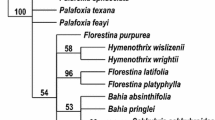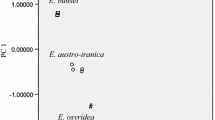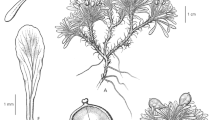Abstract
Ficus (Moraceae) is a keystone group in tropical and subtropical forests with remarkable diversity of species and taxonomical challenges as a consequence of fig–pollinator coevolution. Ficus subsect. Frutescentiae includes about 30 species that are predominantly shrubs or small trees with Terminalia branching. Many of these species are difficult to delimit morphologically, and the group includes a tangle of uncertain taxa and incorrectly applied names. We conducted a phylogenetic analysis with internal and external transcribed spacer data (ITS and ETS) and data from 18 polymorphic microsatellite loci to evaluate the species status of the most perplexing members of this subsection. The results confirm the monophyly of subsect. Frutescentiae, with F. pedunculosa as sister to the rest. The F. erecta complex comprises approximately 17 taxa: F. erecta, F. abelii, F. boninsimae, F. nishimurae, F. iidaiana, F. gasparriniana var. laceratifolia, F. gasparriniana var. viridescens, F. pyriformis, F. stenophylla, F. fusuiensis, F. fengkaiensis, F. sinociliata, F. tannoensis, F. vaccinioides, F. formosana, F. pandurata, and F. periptera. The last five of these were supported as good species, while the others were not well supported by the present evidence. Evidence also supported the status of the non-F. erecta complex species including. F. pedunculosa, F. ischnopoda, F. heteromorpha, and F. variolosa. Ficus filicauda and F. neriifolia are possibly conspecific. The species status of F. potingensis should be restored and it should be treated as a member of section Eriosycea. Identification of the remaining taxa (F. gasparriniana var. esquirolii, F. ruyuanensis, F. daimingshanensis, F. chapaensis, F. changii, F. trivia, and F. tuphapensis) and their relationships to the F. erecta complex were not clarified. As a whole, only ten species in this subsection are confirmed, one is excluded, one is synonymous, and the others are either unresolved or short of samples. There appears to be a consistent genetic background among these unresolved groups, which suggests that repeated hybridization (as a result of pollinator host shifts) has filled up the interspecific gaps during the fig–pollinator coevolution process.



Similar content being viewed by others
References
Anand K, Jena SN, Chaudhary LB, Singh M (2016) Conflict between morphological and molecular data: a case study of Ficus krishnae (Moraceae). Phytotaxa 247:143–147. doi:10.11646/phytotaxa.247.2.7
Azuma H, Harrison RD, Nakamura K, Su ZH (2010) Molecular phylogenies of figs and fig-pollinating wasps in the Ryukyu and Bonin (Ogasawara) islands, Japan. Genes Genet Systems 85:177–192. doi:10.1266/ggs.85.177
Baldwin BG, Markos S (1998) Phylogenetic utility of the external transcribed spacer (ETS) of 18S-26S rDNA: congruence of ETS and ITS trees of Calycadenia (Compositae). Molec Phylogen Evol 10:449–463. doi:10.1006/mpev.1998.0545
Bandelj D, Javornik B, Jakse J (2007) Development of microsatellite markers in the common fig, Ficus carica L. Molec Ecol Notes 7:1311–1314. doi:10.1111/j.1471-8286.2007.01866.x
Béna G, Jubier MF, Olivieri I, Lejeune B (1998) Ribosomal external and internal transcribed spacers: combined use in the phylogenetic analysis of Medicago (Leguminosae). J Molec Evol 46:299–306. doi:10.1007/PL00006306
Berg CC (2003a) Flora Malesiana precursor for the treatment of Moraceae 1: the main subdivision of Ficus: the subgenera. Blumea 48:167–178. doi:10.3767/000651903X686132
Berg CC (2003b) Flora Malesiana precursor for the treatment of Moraceae 3: Ficus subgenus Ficus. Blumea 48:529–550. doi:10.3767/000651903X489537
Berg CC (2011) Ficus trivia (Moraceae) redefined. Edinburgh J Bot 68:269–272. doi:10.1017/S0960428611000114
Berg CC, Corner EJH (2005) Moraceae (Ficus). In: Nooteboom HP (ed) Flora Malesiana. Series I–Seed plants, vol 17, part 2. Nationaal Herbarium Nederland, Leiden, pp 1–730. doi:10.1663/0007-196X(2006)58[194:BR]2.0.CO;2
Berg CC, Wiebes JT (1992) African fig trees and fig wasps. Verh Kon Ned Akad Wetensch Afd Natuurk Sect 2 89:1–298
Berg CC, Pattharahirantricin N, Chantarasuwan B (2011) Moraceae. In: Santisuk T, Larsen K (eds) Flora of Thailand. The Forest Herbarium, National Park, Wildlife and plant Conservation Department, Bangkok, pp 475–675
Burland TG (2000) DNASTAR’s Lasergene sequence analysis software. Meth Molec Biol 132:71–91. doi:10.1385/1-59259-192-2:71
Chang SS (1982) Three new species of the Moraceae from China. Acta Phytotax Sin 20:97–98 (in Chinese)
Chang SS (1983) New taxa of Moraceae from China. Guihaia 3:295–306 (in Chinese)
Chang SS (1984) New taxa of Moraceae from China and Vietnam. Acta Phytotax Sin 22:68–71 (i n Chinese)
Chang SS, Wu CY (1998) Moraceae (Ficus). In: Chang SS, Wu CY, Cao ZY (eds) Flora reipublicae popularis sinicae 23(1). Science Press, Beijing, pp 66–169 (in Chinese)
Chen CH, Chou LY (1997) The Blastophagini of Taiwan (Hymenoptera: Agaonidae: Agaoninae). J Taiwan Mus 50:113–154
Chen Y, Li HQ, Ma WL (2002) Relationships between Ficus erecta var. beecheyana and two Sycophilus wasps. Zool Res 33:38–43
Corner EJH (1965) Check-list of Ficus in Asia and Australasia with keys to identification. Gard Bull Singapore 21:1–186
Cornille A, Underhill JG (2011) Floral volatiles, pollinator sharing and diversification in the fig-wasp mutualism: insights from Ficus natalensis, and its two wasp pollinators (South Africa). Proc Roy Soc B 279:1731–1739. doi:10.1098/rspb.2011.1972
Cruaud A, Rønsted N, Chantarasuwan B, Chou LS, Clement WL, Couloux A, Cousins B, Genson G, Harrison RD, Hanson PE, Hossaert-Mckey M, Jabbour-Zahab R, Jousselin E, Kerdelhué C, Kjellberg F, Lopez-Vaamonde C, Peebles J, Peng YQ, Pereira RAS, Schramm T, Ubaidillah R, van Noort S, Weiblen GD, Yang DR, Yodpinyanee A, Libeskind-Hadas R, Cook JM, Rasplus JY, Savolainen V (2012) An extreme case of plant-insect codiversification: figs and fig-pollinating wasps. Syst Biol 61:1029–1047. doi:10.1093/sysbio/sys068
Doka G (2013) Excel 3-D scatter plot. Doka LCA. Available at: http://www.doka.cn/Excel3Dscatterplot.htm
Dong HJ, Peng H (2014) Relationships within the Lonicera macrantha complex based on morphological and molecular data. Plant Divers Res 36(2):133–141. doi:10.7677/ynzwyj201413094
Doweld AB (2016) Ficus changii, Ficus fengkaiensis, Ficus obtusatoides and Ficus tethyca (Moraceae), new replacement names. Kew Bull 71:29. doi:10.1007/S12225-016-9641-x
Doyle JJ, Doyle JL (1987) A rapid DNA isolation procedure from small quantities of fresh leaf tissue. Phytochem Bull 19:11–15
Fang D, Qin DH (2001) New plants from limestone regions of Guangxi, China. Acta Phytotax Sin 39:547–552 (in Chinese)
Farris JS, Kallersjo M, Kluge AG, Bult C (1994) Testing significance of incongruence. Cladistics 10:315–319. doi:10.1111/j.1096-0031.1994.tb00181.x
Felsenstein J (1985) Confidence limits on phylogenies: an approach using the bootstrap. Evolution 39:783–791. doi:10.2307/2408678
Garcia M, Bain A, Tzeng HY, Peng YQ, Chou LS, Kjellberg F (2012) Portable microsatellite primers for Ficus (Moraceae). Amer J Bot 99:e187–e192. doi:10.3732/ajb.1100485
Giraldo E, Viruel MA, López-Corrales M, Hormaza JI (2005) Characterisation and cross-species transferability of microsatellites in the common fig (Ficus carica L.). J Hort Sci Biotech 80:217–224. doi:10.1080/14620316.2005.11511920
Herre EA, Machado CA, Bermingham E, Nason JD, Windsor DM, McCafferty SS, van Houten W, Bachmann K (1996) Molecular phylogenies of figs and their pollinator wasps. J Biogeogr 23:521–530. doi:10.1111/j.1365-2699.1996.tb00014.x
Hill DS (1967) Fig-wasps (Chalcidoidea) of HongKong I. Agaonidae. Zool Verh 89:3–55
Ickert-Bond SM, Pigg KB, Wen J (2005) Comparative infructescence morphology in Liquidambar (Altingiaceae) and its evolutionary significance. Amer J Bot 92:1234–1255. doi:10.3732/ajb.92.8.1234
Janzen DH (1979) How to be a fig. Annual Rev Ecol Syst 10:13–51. doi:10.1146/annurev.es.10.110179.000305
Jousselin E, Rasplus JY, Kjellberg F (2003) Convergence and coevolution in a mutualism: evidence from a molecular phylogeny of Ficus. Evolution 57:1255–1269. doi:10.1554/02-445
Khadari B, Hochu I, Santoni I, Kjellberg F (2001) Identification and characterization of microsatellite loci in the common fig (Ficus carica L.) and representative species of the genus Ficus. Molec Ecol Notes 1:191–193. doi:10.1046/j.1471-8278.2001.00072.x
Korine C, Kalko EKV, Herre EA (2000) Fruit characteristics and factors affecting fruit removal in a Panamanian community of strangler figs. Oecologia 123:560–568. doi:10.1007/PL00008861
Kusumi J, Azuma H, Tzeng HY, Chou LS, Peng YQ, Nakamura K, Su ZH (2012) Phylogenetic analyses suggest a hybrid origin of the figs (Moraceae: Ficus) that are endemic to the Ogasawara (Bonin) Islands, Japan. Molec Phylogen Evol 63:168–179. doi:10.1016/j.ympev.2012.01.004
Lambert FR, Marshall AG (1991) Keystone characteristics of bird-dispersed Ficus in a Malaysian lowland rain forest. J Ecol 79:793–809. doi:10.2307/2260668
Leighton M, Leighton DR (1983) Vertebrate responses to fruiting seasonality within a Bornean rain forest. In: Whitmore TC, Chadwick AC, Sutton SL (eds) Tropical rain forest: ecology and management. Blackwell, Oxford, pp 181–196
Li HQ, Chen Y, Lu XN, Ma WL (2003) Reproductive biology of Ficus erecta Thunb. Acta Ecol Sin 21:1385–1387 (i n Chinese with English abstract)
Li HQ, Chen JY, Wang S, Xiong SZ (2012a) Evaluation of six candidate DNA barcoding loci in Ficus (Moraceae) of China. Molec Ecol Res 12:783–790. doi:10.1111/j.1755-0998.2012.03147.x
Li HQ, Wang S, Chen JY, Gui P (2012b) Molecular phylogeny of Ficus section Ficus in China based on four DNA regions. J Syst Evol 50:422–432. doi:10.1111/j.1759-6831.2012.00221.x
Linder CR, Goertzen LR, Heuvel BV, Francisco-Ortega J, Jansen RK (2000) The complete external transcribed spacer of 18S-26S rDNA: amplification and phylogenetic utility at low taxonomic levels in Asteraceae and closely allied families. Molec Phylogen Evol 14:285–303. doi:10.1006/mpev.1999.0706
Lu J, Gui P, Lu ZL, Zhang LF, Tian HZ, Gilbert MG, Li HQ (2016) Phylogenetic analysis and taxonomic delimitation of the “Hairy-Fig” complex of Ficus sect. Eriosycea (Moraceae) in China. Phytotaxa 261:121–136. doi:10.11646/phytotaxa.261.2.2
Nylander JAA (2004) MrModeltest v2. Program distributed by the author, Evolutionary Biology Centre, Uppsala University, Uppsala. Available at: https://github.com/nylander/MrModeltest2
Ogunkunle ATJ, Oladele FA (2008) Leaf epidermal studies in some Nigerian species of Ficus L. (Moraceae). Pl Syst Evol 274:209–221. doi:10.1007/s00606-008-0044-9
Peakall ROD, Smouse PE (2012) GenALEX 6.5: genetic analysis in Excel. Population genetic software for teaching and research—an update. Bioinformatics 28:2537–2539. doi:10.1093/bioinformatics/bts460
Posada D, Buckley TR (2004) Model selection and model averaging in phylogenetics: advantages of akaike information criterion and Bayesian approaches over likelihood ratio tests. Syst Biol 53:793–808. doi:10.1080/10635150490522304
Rambaut A (2012) FigTree version 1.4.0. Available at: http://tree.bio.ed.ac.uk/software/figtree
Renoult JP, Kjellberg F, Grout C, Santoni S, Khadari B (2009) Cyto-nuclear discordance in the phylogeny of Ficus section Galoglychia and host shifts in plant-pollinator associations. BMC Evol Biol 9:248. doi:10.1186/1471-2148-9-248
Ronquist F, Huelsenbeck JP (2003) MrBayes 3: bayesian phylogenetic inference under mixed models. Bioinformatics 19:1572–1574. doi:10.1093/bioinformatics/btg180
Rønsted N, Weiblen GD, Cook JM, Salamin N, Machado CA, Savolainen V (2005) 60 million years of co-divergence in the fig-wasp symbiosis. Proc Roy Soc B 272:2593–2599. doi:10.1098/rspb.2005.3249
Rønsted N, Weiblen GD, Clement W, Zerega N, Savolainen V (2008) Reconstructing the phylogeny of figs (Ficus, Moraceae) to reveal the history of the fig pollination mutualisms. Symbiosis 45:45–56
Sang T, Crawford DJ, Stuessy TF (1997) Chloroplast DNA phylogeny, reticulate evolution, and biogeography of Paeonia (Paeoniaceae). Amer J Bot 84:1120–1136
Swofford DL (2003) PAUP*: phylogenetic Analysis using Parsimony (*and Other Methods) Version 4.0b10. Sinauer Associates, Sunderland
Tamura K, Peterson D, Peterson N, Stecher G, Nei M, Kumar S (2011) MEGA5: molecular evolutionary genetics analysis using maximum likelihood, evolutionary distance, and maximum parsimony methods. Molec Biol Evol 28:2731–2739. doi:10.1093/molbev/msr121
Wachi N, Kusumi J, Tzeng HY, Su ZH (2016) Genome-wide sequence data suggest the possibility of pollinator sharing by host shift in dioecious figs (Moraceae, Ficus). Molec Ecol 25:5732–5746. doi:10.1111/mec.13876
Wang G, Cannon CH, Chen J (2016) Pollinator sharing and gene flow among closely related sympatric dioecious fig taxa. Proc Roy Soc B 283:20152963. doi:10.1098/rspb.2015.2963
Weiblen GD (2000) Phylogenetic relationships of functionally dioecious Ficus (Moraceae) based on ribosomal DNA sequences and morphology. Amer J Bot 87:1342–1357
White TJ, Bruns T, Lee S, Taylor J (1990) Amplification and direct sequencing of fungal ribosomal RNA genes for phylogenetics. In: Innis MA, Gelfand DH, Sninsky JJ, White TJ (eds) PCR protocols: a guide to methods and applications. Academic Press, San Diego, pp 315–322
Wiebes JT (1979) Co-evolution of figs and their insect pollinators. Annual Rev Ecol Syst 10:1–12. doi:10.1146/annurev.es.10.110179.000245
Wiebes JT (1994) The Indo-Australian Agaoninae (pollinators of figs). Verh Kon Ned Akad Wetensch Afd Natuurk Sect 2 92:1–208
Wiebes JT (1995) The New world Agaoninae (pollinators of figs). Verh Kon Ned Akad Wetensch Afd Natuurk Sect 2 94:1–60
Xu L, Harrison RD, Yang P, Yang DR (2011) New insight into the phylogenetic and biogeographic history of genus Ficus: vicariance played a relatively minor role compared with ecological opportunity and dispersal. J Syst Evol 49:546–557. doi:10.1111/j.1759-6831.2011.00155.x
Yamazaki T (1983) Taxonomic review of the Moraceae from Japan, Korea, Taiwan and adjacent areas (2). J Phytogeogr Taxon 31:1–15
Zhang J, Jiang K, Shi YS, Liu M, Chen XY (2011) Development and polymorphism of microsatellite primers in Ficus pumila L. (Moraceae). Amer J Bot 98:e170–e172. doi: 10.3732/ajb.1000340
Zhou ZK, Gilbert MG (2003) Moraceae. In: Wu ZY, Raven PH (eds) Flora of China 5. Science Press and Missouri Botanical Garden Press, Beijing and St. Louis, pp 37–71
Zimisuhara B, Valdiani A, Shaharuddin NA, Qamaruzzaman F, Maziah M (2015) Structure and principal components analyses reveal an intervarietal fusion in Malaysian mistletoe fig (Ficus deltoidea Jack) populations. Int J Molec Sci 16:14369–14394. doi:10.3390/ijms160714369
Zwickl DJ (2006) Genetic algorithm approaches for the phylogenetic analysis of large biological sequence datasets under the maximum likelihood criterion. PhD Thesis, The University of Texas, Texas
Acknowledgements
This study was funded by the National Natural Science Foundation of China (Grant No. 31270242) and the work was carried out in the laboratory of the School of Life Sciences, East China Normal University. The authors of this paper are grateful to the curators of the herbaria P, KUN, IBK, IBSC, PE, UPS, and K for providing support by checking specimens or photos. The authors also thank Mr. Bin-Jie Ge, Qi Tian (Shanghai Chenshan Botanical Garden, Shanghai, China), Mr. Shuang Wang, Ms. Ji-Yun Chen, Ping Gui, Shen-Zhan Xiong, Qiu-Shi Wang, Xiao-Mei Wang, and Hai-Yan Gao (East China Normal University) for their help in gathering specimens, and Dr. Dirk C. Albach (Carl von Ossietzky-Universität Oldenburg, Germany) for critical reading of the manuscript.
Author information
Authors and Affiliations
Corresponding author
Additional information
Handling editor: Yunpeng Zhao.
Electronic supplementary material
Below is the link to the electronic supplementary material.
Information on Electronic Supplementary Material
Information on Electronic Supplementary Material
Online Resource 1. Details of samples included in this study.
Online Resource 2. Codom-genotypic data of the 18 polymorphic SSR loci.
Online Resource 3. Alignment for phylogenetic trees reconstruction based on ETS matrix.
Online Resource 4. Alignment for phylogenetic trees reconstruction based on ITS matrix.
Online Resource 5. Alignment for phylogenetic trees reconstruction based on ITS + ETS matrix.
Online Resource 6. Alignment for phylogenetic trees reconstruction based on psbA–trnH matrix.
Online Resource 7. The Bayesian majority consensus tree on psbA–trnH sequence data.
Online Resource 8. The Bayesian majority consensus tree from ITS sequence data.
Online Resource 9. The Bayesian majority consensus tree on ETS sequence data.
Rights and permissions
About this article
Cite this article
Lu, ZL., Zhang, Z., Zhou, QM. et al. Molecular analyses of Ficus erecta and its allies within the subsection Frutescentiae (Moraceae). Plant Syst Evol 303, 603–614 (2017). https://doi.org/10.1007/s00606-017-1393-z
Received:
Accepted:
Published:
Issue Date:
DOI: https://doi.org/10.1007/s00606-017-1393-z




